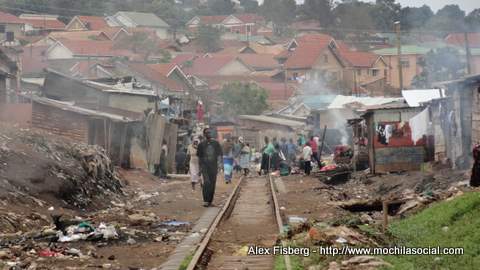This text was kindly translated by Tania F. Cannon. Many thanks!I learned my lesson: planning is important, but having the ears and the heart open makes much more difference in my day-to-day than following itineraries. I arrived in Uganda almost at down, after traveling almost 10 hours in a bus that looked more like a ship: wood ceiling with round lamps, seats torn from an old living room and screwed to the carpeted floor and individual plugs decorated in gold (ok, golden).
I got off in the middle of the road to follow the instructions sent by my Couchsurfing contact. Carrying my house on my back and my office on my belly, I get always a little antsy about walking around displaying my belongings. And, this time, I froze for seconds, without knowing exactly what to do. The situation was the following: I should follow straight to the street ahead of me, turn the first right and after three blocks turn left, pass an antenna and enter through a gate marked by diamond-shaped rocks. Easy, if not for the total darkness (not even a light source in a gigantic radius) and the total loneliness of the moment.
I started walking towards the darkness, but I went back to the road. Then, I resumed walking, feeling as if I just got into a very cold shower. After all, if the instructions were to follow this road, and my colleague knew that I would be arriving at this time, nothing bad could happen. After the first turn, the lights of a car lit the road, but just for a little while. The fellow approached me, asked me where I was heading to and warned me of the dangers of walking alone on that road. As usual, I made up some stories about how comfortable and safe I was feeling at the moment, but I ended up getting a ride to the house.
Contradicting my paulistana luggage and the opinion of my ride driver, the road showed to be perfectly safe in the following days. With the ongoing blackouts in the city (a subject for another text), walking in total darkness became a routine in Kampala. Sometimes it is quite difficult for me to disassociate from the reality I had in São Paulo, fearing for my belongings, for my life and for the life of people around me. But so far, East Africa has given me lessons of social interaction and a wealth of thoughts for my research on poverty.
I had handpicked my Couchsurfer. In his profile, he described himself as a specialist in the TIC sector for development and worked in several projects in Uganda trying to develop platforms based on mobile technology for social development. I was not really surprised with the couple that hosted me, but when I woke up the next day I was invited by a person related to them to visit Namuwongo, the key slum for my research in Uganda, for a documentary filming.
I did not think twice, I took a boda-boda (a motorcycle-taxi) to Namuwongo and met with the Film4Change team. I would be watching from distance the entire filming of a documentary about the slum to be conducted by a team from Uganda , which was trained the year before by an international organization. To me, this was an opportunity to observe the environment and make initial contacts for the following weeks.
At the gate, we left behind an Italian organization of International cooperation and we walked to the entrance of what is considered as the slum. Two different worlds. After crossing the railroad that separates the “city“ from the slum, we climbed a small hill covered by trash until we reached the narrow entrance of houses on the dirt soil. No clusters in this area. It was possible to watch the endless movements of people from one side to the other, running small businesses or busy with handcrafts on the so-called pavement.
The documentary producers were busy trying to redo a drowning scene that took place weeks before our visit, but the movement and the composition of that scenery would, at any day, serve as subject for another hundreds of videos, studied and considerations. But obviously, there are not many people interested in that reality. The crowd of curious people was justified: muzungos, professional movie cameras, tripods, microphones and breaches of protocol with the elected local community leader.
Facing the creek that separates the community and a piece of land covered with small plantations, young people were representing a routine scene of the region: the drowning of a youngster or of a child, trapped by the unstable and swampy land, in the backyard of the houses in Namuwongo. The children that followed us seemed not to care about it – or were not aware of the risks– and walked along barefoot, stepping on feces, open sewerage and trash, a lot of trash.
Women show up from the middle of the forest carrying long stems of sugar cane on their heads. Slowly they cross the murky waters that reach their bellies, heading to the side where I stand, the safe side. Without losing their balance – and with no help whatsoever – they reach the not-so stable ground, and continue carrying their harvest heading to the slum. One of the pieces of sugar cane is handed to the children, who violently bite it and devour the unpeeled sugar cane.
The adventure comes to an end when the filmed scene finishes, and the community slowly returns to their daily routine. The same group of children that showed me the way in now takes me to the opposite direction, to the way “out”. The sun was scorching throughout the whole day spent in Namuwongo, but now, thunders bring the threat of strong rain. How would the life be in a slum – with no sanitation and located at the edge of a filthy creek - when it rains?


 RSS Feed
RSS Feed